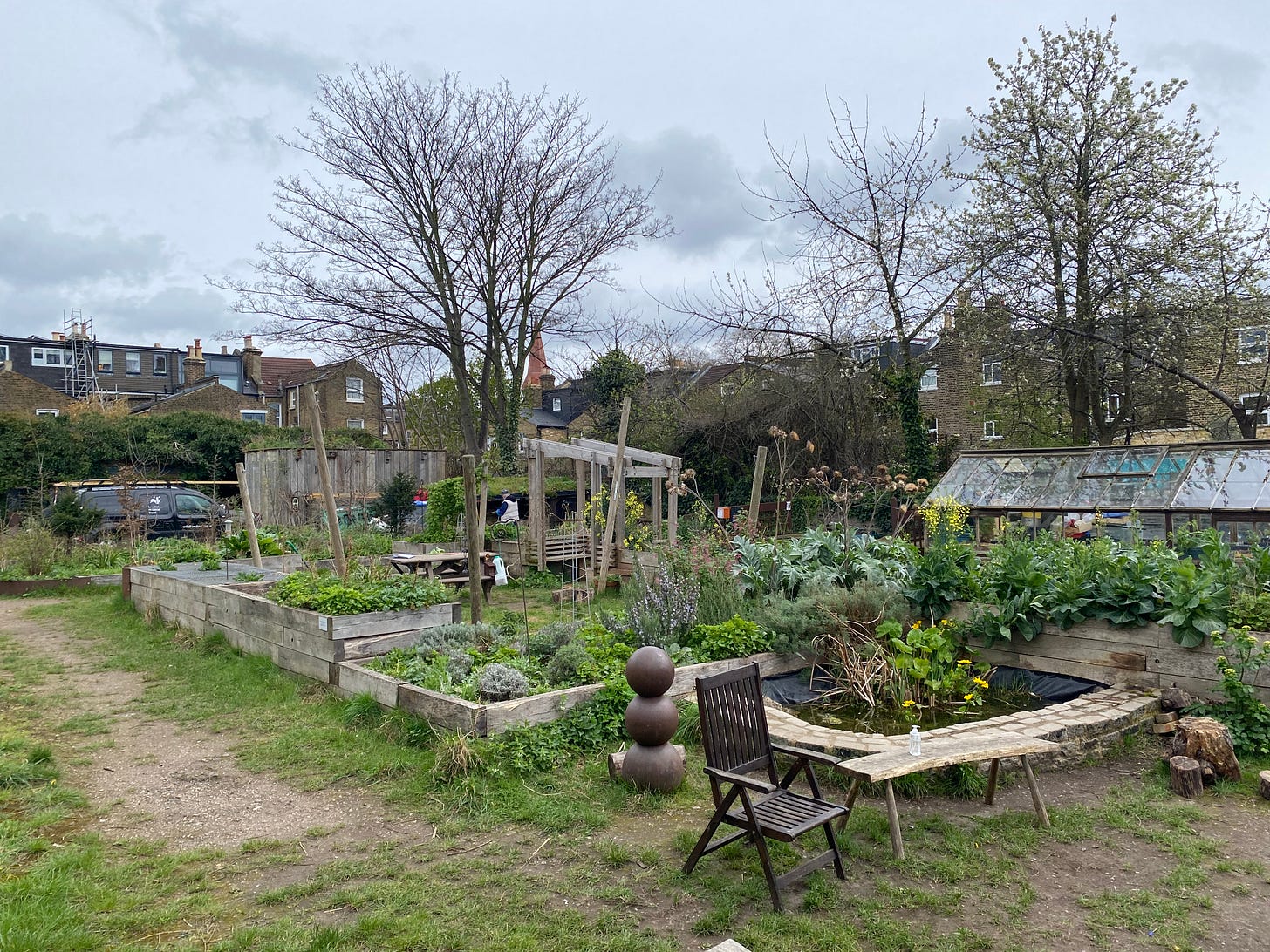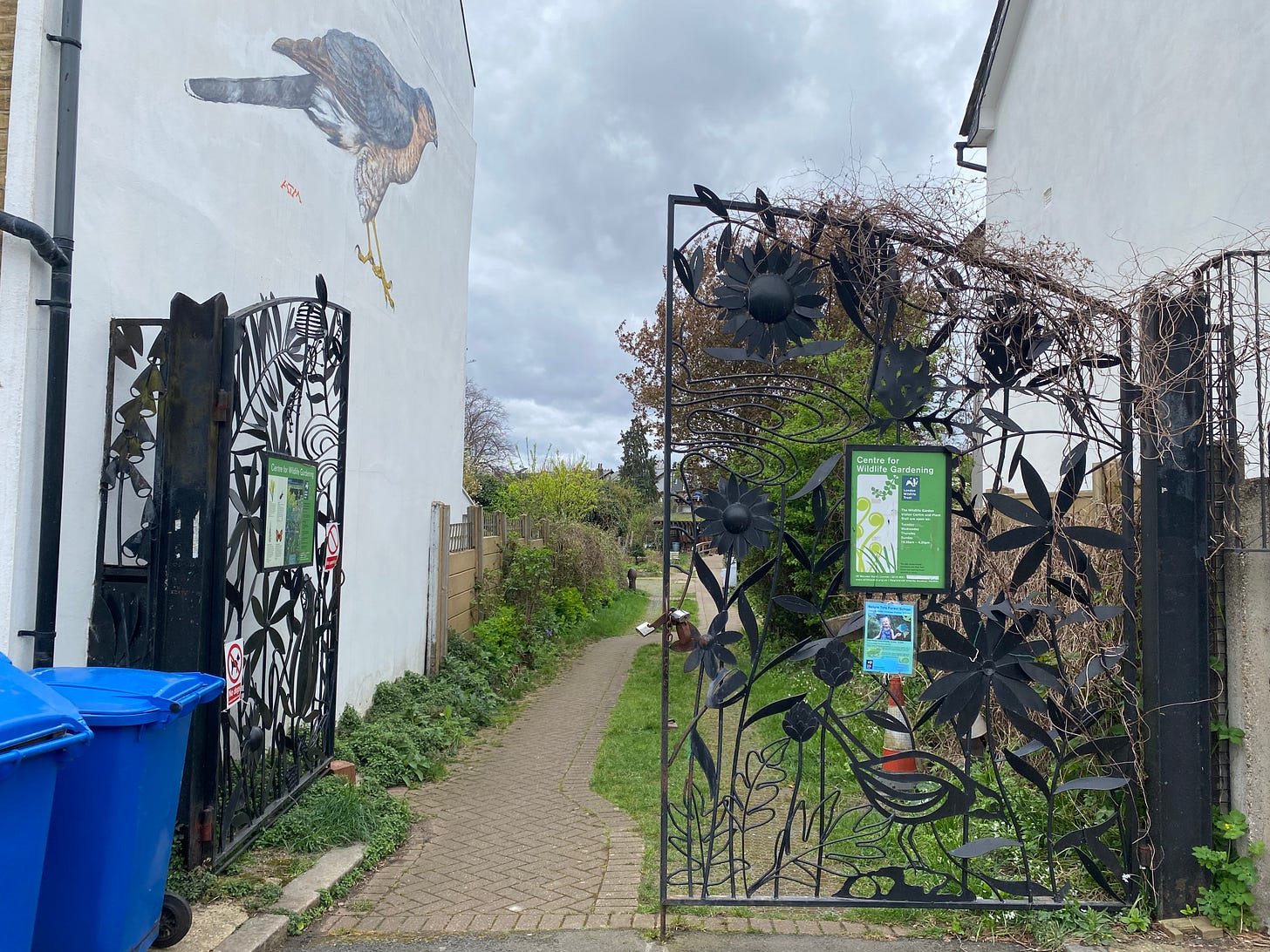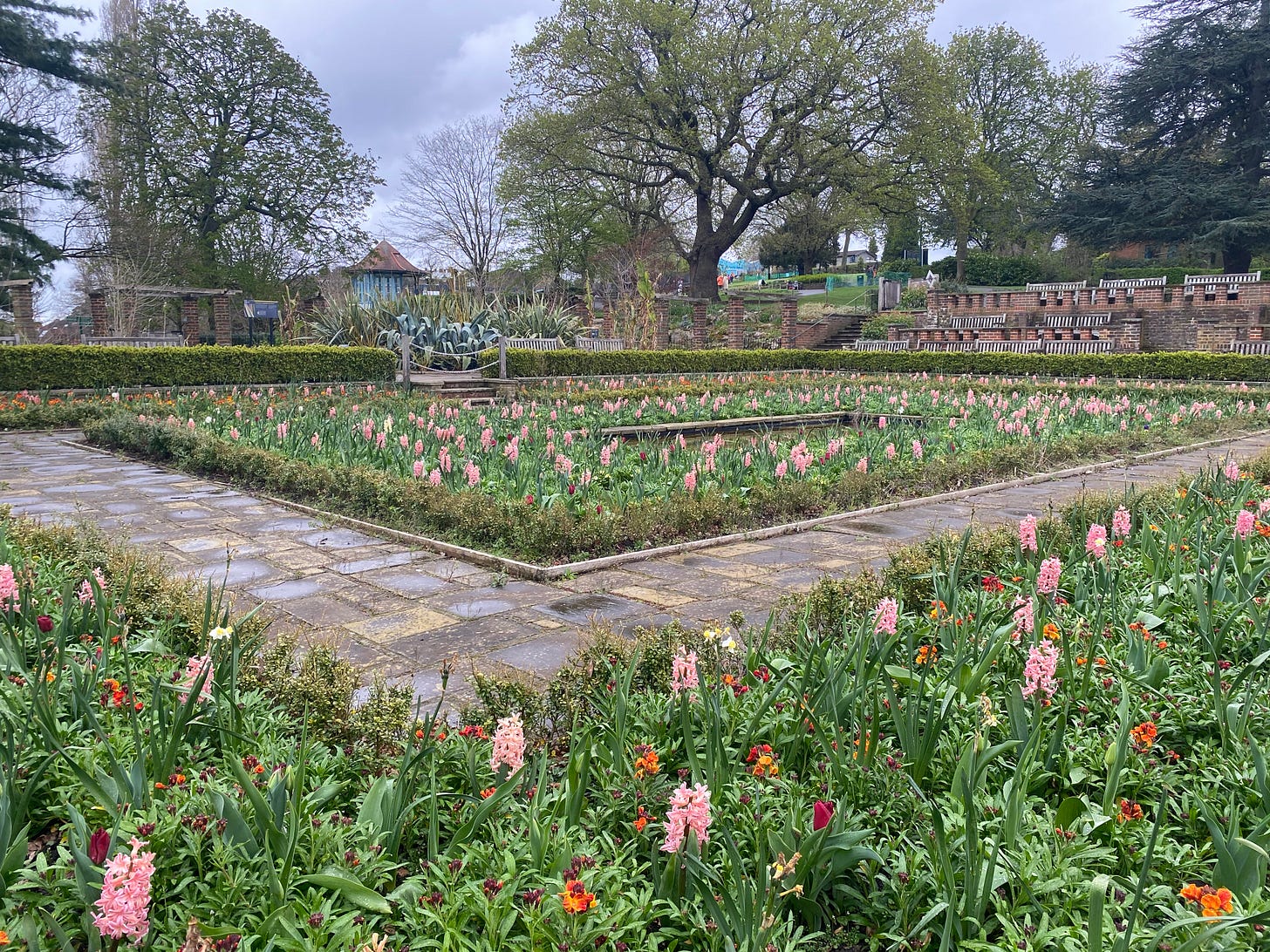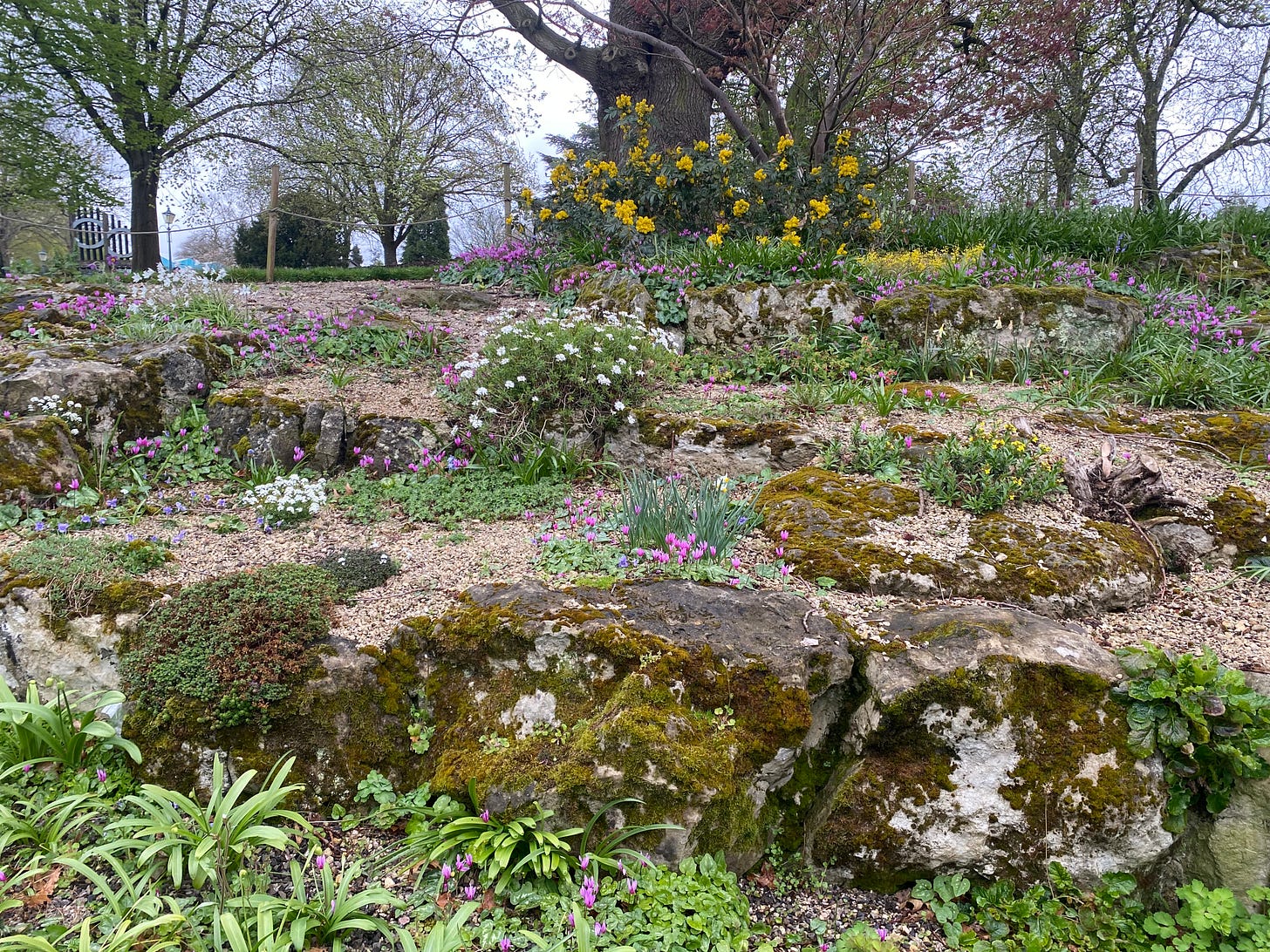The power of fresh perspective
Sometimes it takes a visit from an outsider to help you to appreciate what’s sitting right in front of you
You’re reading The Earthworm, a newsletter that takes a sideways look at the world of gardens, gardening, horticulture and all that good green stuff. If this is your first time here, you can catch up on anything you’ve missed by following this link. Subscribe now for free and join the community! You can also support me and my work on The Earthworm by upgrading to a paid subscription at any time – just tap the button below.
I was reminded the other day of a scene from the early 00s animated comedy series Futurama. The scene in question is from an episode called ‘I Dated A Robot’, in which Fry – a pizza delivery boy from the 20th century who accidentally stumbled into a cryogenic freezer on Millennium Eve only to eventually thaw out 1,000 years later – decides he wants to live out all his futuristic dreams.
When Fry announces that he wants to visit the edge of the universe, his friends and colleagues duly oblige and take him there – “there” being a parking lot adjacent to an underwhelming viewing deck looking out into infinite blank nothingness. The edge of the universe, to inhabitants of the 31st century, is reduced to an everyday roadside attraction.
The reason it came to mind is because when they arrive, one of Fry’s companions says: “It's funny. You live in the universe, but you never do these things till someone comes to visit.” And I think that is a sentiment that we can all relate to.
London is one of the world’s premiere tourist destinations, with some of the world’s most recognisable landmarks. But the feeling articulated in that Futurama scene is universal. Wherever you live, you will walk past things every day – a building, a post box, a shop, a meadow – that is so available, so accessible, so ever-present, that you barely register its existence. You certainly don’t stop to appreciate it; to really look at it. Until, of course, someone comes to visit.
As I mentioned in a post from earlier this week, I recently spent some time with Boaz Frankel, the author of Rootbound. We met via Substack. Like me, Boaz is passionate about plants. While he was here – he was in town to see some London-based friends – he wanted to make the most of the opportunity to visit as many gardens and green spaces as he could.
Considering its size and status as one of the world’s great metropolises, London is blessed with very many of these gardens and green spaces. Some, like Hampstead Heath or Epping Forest, I have spent hundreds of hours traipsing, exploring and enjoying. Others, I have hardly given a second thought. The rose garden in Regent’s Park might as well be Madame Tussaud’s; the Royal Botanical Gardens at Kew could just as easily be the London Dungeon, or Harrods, or Leicester Square. They are the sorts of places I could go anytime I want, and therefore never go at all.
So when Boaz said he was coming, and we agreed that it would be fun to meet up and talk about our experiences of gardening and writing about gardening, all that was left was to choose a destination. In the end, we settled on two South London locations: the Horniman Museum and Gardens (my suggestion), and the London Wildlife Trust’s Centre for Wildlife Gardening (somewhere that had been recommended to Boaz, thanks to an unusual series of events, by TV presenter and writer Kate Bradbury).
I had visited the Horniman’s grounds on a number of occasions previously. But being there with Boaz, I found myself seeing it with new eyes; looking at it all from two perspectives at once. On the one hand, I was trying to take in my surroundings as Boaz might as a first time visitor; but at the same time, I was seeing it through the eyes of a “host”, fretting about whether it was pretty enough, interesting enough, unusual enough to entertain my foreign friend.
As we strolled into the Sunken Gardens – a small area of formal-style planting that you step down into from the surrounding park, and that was full, at the time, of bonfire-hued wallflowers and candy-floss pink hyacinths – I was quick to mention the heady floral scent, as if to say: “don’t our London gardens smell divine?” And when he pulled out his phone to take a picture of the rock garden, I felt a sort of relief. He liked it. Phew.
Boaz is what’s known in the US as a Master Gardener. What this entails varies state by state, but generally refers to someone who has spent time advancing their horticultural knowledge, has volunteered dozens of hours in the literal and/or proverbial field, and has a green-fingered role to play within their community. A kind of local ambassador for gardens. It sounds great.
We don’t really have anything like it here. Then again, from what I gather from speaking to Boaz, we don’t really need it either. Gardening here is in our cultural DNA. Gardens are everywhere, domestic and public, as are opportunities to learn about gardening.
Britain is truly a nation of gardeners – or at least a nation of people where many are fortunate enough to have a garden. As a result, there is an endless stream of magazines, TV programmes, radio shows, YouTube channels, social media accounts, even now a handful of Substacks(!) catering to this interest in beautifying and maintaining our outdoor plots and indoor pots. In the US, it seems, not so much. Where I am trying to make myself heard within a cacophonous British garden media landscape, Boaz in the States is a pioneer, venturing into the Wild West of garden content, in search of his figurative fortune.
From his explorations of London and its green spaces, Boaz will surely have discerned more about the plethora of horticultural differences between Brits and Americans than I from our conversation alone. But one incredibly stark point of difference did stand out to me.
When we left the Horniman in search of a bus stop, to catch the 185 or 176 up Lordship Lane to the Centre for Wildlife Gardening, Boaz asked if we might walk. It would be a 35-minute amble along a fairly busy main road, I warned, but sure. What I soon realised was that Boaz was relishing the opportunity to see the area on foot. “Pittsburgh,” he told me, “is a city designed for cars, not people.”
I remember feeling the same on a previous visit to the States. Many towns and cities there are so car-oriented that they don’t even have pavements (aka sidewalks). If you want to get from A to B, you have no option but to hop in a car. What lies between those two points may be beautiful, but if you want to enjoy it, all you can do is roll down your window or pull over.
So we walked. And as we walked, I noticed. More so even than at the Horniman, I was seeing my city through new eyes. Thanks to Boaz, I was noticing every little detail, as if seeing it for the first time.

We stopped to admire a large front garden being tended to by an elderly man. Here were many of the same plants we’d just enjoyed at the Horniman – the wallflowers, the hyacinths, the odd early tulip – and being maintained with the same diligence and care as those in the far grander setting of the Sunken Garden. Here was a very different sort of place: a private garden in a very public place. An act of community-minded kindness, really. We congratulated the man, thanked him for his efforts, and continued on our way.
The Centre for Wildlife Gardening is a small, tranquil, unassuming garden nestled in a quiet residential enclave between East Dulwich and Peckham. The garden can perhaps best be understood as a series of small rooms, each one offering a human-made habitat for some of London’s luckiest bugs, birds and mammals. Bathtub ponds, green roofs, recycled and upcycled everything – it’s full of inspiration and ideas for welcoming wildlife into your own space. I spotted a newt, which Boaz was pleased to see, and again I silently thanked London for showing its best side to our esteemed visitor.
Over the course of the hours that we spent together, the conversation with Boaz flowed freely. We bonded over our mutual appreciation for the likes of Monty Don and Carol Klein, and Boaz was even kind enough to laugh at my affectionate impersonation of Adam Frost. We talked about the challenges of starting up a new publication, and of getting it out there to people who might be interested to read it. And we talked about our shared approach not just to gardening, but writing about gardens.
As we sat sipping our coffees inside a warehouse in an old industrial estate – hello Peckham – Boaz said something which really resonated with me: “My Substack isn’t going to help you garden, but it might help you to love gardening.” Too right, Boaz, too right.
I walked him to Peckham Rye station and we said our goodbyes. It was a real pleasure to spend time with a new friend, and to spend the morning exploring a green corner of London that I simply don’t visit often enough. And it was also a pleasure to be reminded that one of the great beauties of being a gardener is that you can take your hobby with you wherever you go.
If you’re into baking, you need to be in a kitchen; if rock climbing is your thing, well, you’ll need a decent-sized boulder, at the very least. But plants are everywhere. From the trees that line our kerbs to the weeds occupying cracks in the pavement and the flowers poking out of people’s front yards, for the gardener there is always something to be seen and to be enjoyed. Sometimes, though, you just need a nudge to notice. Thanks, Boaz, for the nudge.
Your thoughts and comments are always welcome and well-received, so do keep them coming! Whether you hit ‘reply’ to this in your inbox, or leave a public comment on the post, I will always respond. Thanks for reading.










Thanks for writing so kindly about our day in the gardens. I'd been holding off on reading it until I'd made a little more progress on my post chronicling the visit. Stay tuned for my take coming on Sunday!
Loved this one Dan, maybe my favourite so far. Seems like you and Boaz really share a similar outlook, which might not be essential to either of your work, though bloody lovely at the very least.